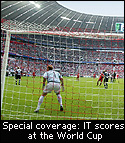Intrusion detection key to World Cup success

After a failed attempt to illegally access the FIFA World Cup IT network at the Korea and Japan games four years ago, more emphasis has been placed on intrusion detection processes.
Instead of depending on off-the-shelf applications, FIFA's infrastructure will rely on an uber-IDS (intrusion detection system) made up of a combination of tools customised by Avaya's World Cup team.
"I've had a security team of three people working with FIFA since the middle of 2004 defining FIFA's IT security policy, and going to the German government and getting their agreement on the security policy.
"We haven't chosen a particular security vendor to work with. Dr Tom Potter from my team -- who's the head of [IT] security -- has built the IDS using a whole lot of tools that are available in the market," said Doug Gardner, Avaya's FIFA World Cup program managing director.
"After the World Cup, we will publish a detailed white paper on what we did and how we did it in terms of security," he said during a visit to ZDNet Australia's office in Sydney today.
Avaya has been the official converged communications provider for the World Cup since 2002. It is responsible for the design, deployment and management of network infrastructure at all 12 stadiums in Germany.
Apart from WAP encryption, Avaya will be scanning PCs and changing passwords on a daily basis, he said. "There's also a whole lot of security tools that we're using to make sure the wireless [network] is secure from outside access and also between journalists so noone can pull someone else's photos off the air and off the network," he added.
Frankfurt-based Gardner said the biggest difference between Korea-Japan and Germany will be the use of a single network.
"In 2002, the stadiums in Korea had traditional voice and data networks separate; in Japan, we used a converged network, which wasn't really 100 percent IP-based.
"2006 will be a fully converged network where all the stadiums will run on a single voice and data network, and [the stadiums] will be connected with IP trunking.
"As far as installation goes, this makes it much simpler because you don't have to worry about two separate sets of cabling," Gardner said.

He also explained that a converged network is more efficient: "If FIFA needs to move a person from one office to another, they simply pick up the phone, pick up their notebook, go to the other office and plug them in. We don't have to do any changes to move them. As far as cost goes, one set of infrastructure means less technical support".
The 31-day program will kick off in Munich on June 9 and the network is expected to provide communications to more than 15,000 FIFA officials and hundreds of journalists covering the event. Avaya estimates the network will handle15 trillion bytes of converged voice and data traffic during the tournament.
| Watch the video |